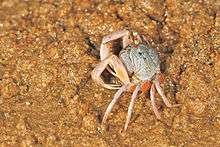Dotilla myctiroides
| Dotilla myctiroides | |
|---|---|
 | |
| Dotilla myctiroides from Devbagh, Karwar, India | |
| Scientific classification | |
| Kingdom: | Animalia |
| Phylum: | Arthropoda |
| Subphylum: | Crustacea |
| Class: | Malacostraca |
| Order: | Decapoda |
| Infraorder: | Brachyura |
| Family: | Dotillidae |
| Genus: | Dotilla |
| Species: | myctiroides |
| Binomial name | |
| Dotilla myctiroides (H. Milne-Edwards, 1852) | |
Dotilla myctiroides is a species of sand bubbler crab found on sea coasts in tropical Asia and East Asia, from Karachi to Japan.[1] They breed throughout the year but activity peaks during the monsoons. This species builds a burrow, called an "igloo", in unstable sand as well as in well-drained and firm sand. In building the igloo, the crab excavates sand and forms it into spherical pellets. These pellets are used to form a circular wall and roof in the burrow. The resulting structure holds a small amount of air in addition to the crab itself.[2]
References
- ↑ Alcock, Alfred (1900). "Materials for a Carcinological Fauna of India, No. 6: The Brachyura Catometopa, or Grapsoidea". Journal of the Asiatic Society of Bengal. Baptist Mission Press. 69 (3): 368–369. OCLC 18349194.
- ↑ Takeda, Satoshi; Matsumasa, Masatoshi; Yong, Hoi-Sen; Murai, Minoru (1996). ""Igloo" construction by the ocypodid crab, Dotilla myctiroides (Milne-Edwards) (Crustacea; Brachyura): The role of an air chamber when burrowing in a saturated sandy substratum". Journal of Experimental Marine Biology and Ecology. ElSevier. 198 (2): 237–247. doi:10.1016/0022-0981(96)00007-X.
This article is issued from Wikipedia - version of the 7/2/2015. The text is available under the Creative Commons Attribution/Share Alike but additional terms may apply for the media files.